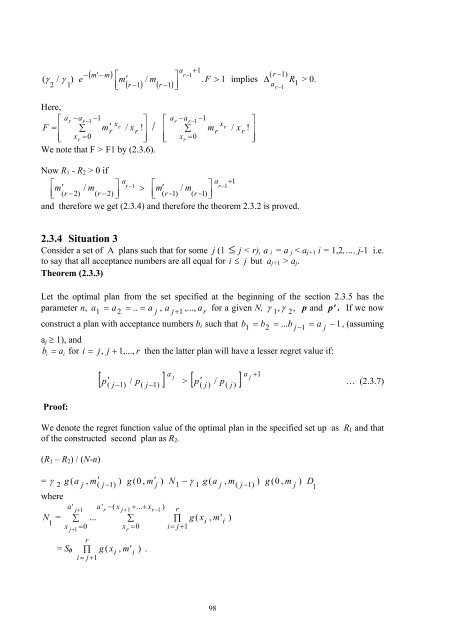Multiattribute acceptance sampling plans - Library(ISI Kolkata ...
Multiattribute acceptance sampling plans - Library(ISI Kolkata ...
Multiattribute acceptance sampling plans - Library(ISI Kolkata ...
Create successful ePaper yourself
Turn your PDF publications into a flip-book with our unique Google optimized e-Paper software.
( γ / )<br />
2 γ − ( m′−<br />
m<br />
e<br />
) /<br />
⎤<br />
1 ⎢⎣<br />
⎡ m<br />
( ′ m<br />
r −1) ( r −1)<br />
⎥⎦<br />
a<br />
r−1<br />
+ 1<br />
. F<br />
> 1<br />
( r −1)<br />
a r<br />
implies ∆ R1<br />
> 0.<br />
−1<br />
Here,<br />
⎡ ar<br />
−ar− 1<br />
−1<br />
⎤<br />
= ⎢ ∑ ′<br />
x<br />
F m r r<br />
/ xr<br />
! ⎥ /<br />
⎢⎣<br />
xr<br />
= 0<br />
⎥⎦<br />
We note that F > F1 by (2.3.6).<br />
⎡<br />
⎢<br />
⎢⎣<br />
a<br />
r<br />
−a<br />
x<br />
r<br />
r<br />
∑<br />
−1<br />
−1<br />
= 0<br />
x<br />
m r r<br />
/ x<br />
r<br />
⎤<br />
! ⎥<br />
⎥⎦<br />
Now R 1 - R 2 > 0 if<br />
a<br />
⎡<br />
m ′ / m<br />
⎤ r−1<br />
><br />
⎡<br />
m ′ / m<br />
⎤ −1<br />
⎢⎣ ( r − 2) ( r − 2) ⎥⎦ ⎢⎣ ( r−1)<br />
( r−1)<br />
⎥⎦<br />
and therefore we get (2.3.4) and therefore the theorem 2.3.2 is proved.<br />
a<br />
r<br />
+ 1<br />
2.3.4 Situation 3<br />
Consider a set of A <strong>plans</strong> such that for some j (1 ≤ j < r), a i = a j < a j+1 i = 1,2,…, j-1 i.e.<br />
to say that all <strong>acceptance</strong> numbers are all equal for i ≤ j but a j+1 > a j .<br />
Theorem (2.3.3)<br />
Let the optimal plan from the set specified at the beginning of the section 2.3.5 has the<br />
parameter n, a<br />
1<br />
= a<br />
2<br />
= .. = a<br />
j<br />
, a<br />
j + 1<br />
,..., ar<br />
for a given N, γ<br />
1, γ 2,<br />
p and p' . If we now<br />
construct a plan with <strong>acceptance</strong> numbers b i such that b<br />
1<br />
= b2<br />
= ... b j − 1 = a<br />
j<br />
− 1, (assuming<br />
a j ≥ 1), and<br />
b = for i = j, j + 1,...,<br />
r then the latter plan will have a lesser regret value if:<br />
i<br />
a i<br />
Proof:<br />
[ ′ a<br />
j<br />
p ] > [ ′ p ]<br />
p ( j −1)<br />
/ ( j −1<br />
)<br />
( j ) /<br />
( j )<br />
a j<br />
+ 1<br />
p … (2.3.7)<br />
We denote the regret function value of the optimal plan in the specified set up as R 1 and that<br />
of the constructed second plan as R 2 .<br />
(R 1 – R 2 ) / (N-n)<br />
= γ<br />
2<br />
g ( a j<br />
, m′<br />
( j −1<br />
) ) g ( 0 , m′ j<br />
) N1 − γ<br />
1<br />
g ( a<br />
j<br />
, m(<br />
j −1<br />
) ) g ( 0 , m<br />
j<br />
)<br />
where<br />
a'<br />
j+<br />
a '<br />
r<br />
−(<br />
x<br />
j+ 1<br />
+ ... + xr−<br />
1<br />
) r<br />
N = ∑ ... ∑ ∏ g ( x<br />
1<br />
i , m'<br />
i )<br />
x 0 x = 0 i=<br />
j + 1<br />
1<br />
j+ 1 =<br />
= S 0 ∏<br />
r<br />
g ( x i , m'<br />
i ) .<br />
i=<br />
j + 1<br />
r<br />
D<br />
1<br />
98
















